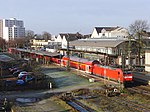Weser-Aller Plains and Geest
The Weser-Aller Plains and Geest (German: Weser-Aller-Flachland) is a natural regional unit of the North German Plain in Germany. It extends over most of the southern catchment of the Aller including the lower reaches of the Oker and Leine and is bounded in the west by the Middle Weser. It is also bounded, from a natural region perspective, by the Stade Geest, the Luneburg Heath, the Wendland and the Altmark in the north; in the east by the Central German Black Earth Region (Mitteldeutsches Schwarzerdegebiet), in the south by the Northern Harz Foreland and Lower Saxon Börde and, in the west, by the Dümmer-Geest Lowland and Ems-Hunte Geest. In the BfN numbering scheme it is number D31.
Excerpt from the Wikipedia article Weser-Aller Plains and Geest (License: CC BY-SA 3.0, Authors).Weser-Aller Plains and Geest
Schwüblingser Straße,
Geographical coordinates (GPS) Address Nearby Places Show on map
Geographical coordinates (GPS)
| Latitude | Longitude |
|---|---|
| N 52.390833333333 ° | E 10.120833333333 ° |
Address
Schwüblingser Straße (K 131)
Schwüblingser Straße
31275 (Arpke)
Lower Saxony, Germany
Open on Google Maps






